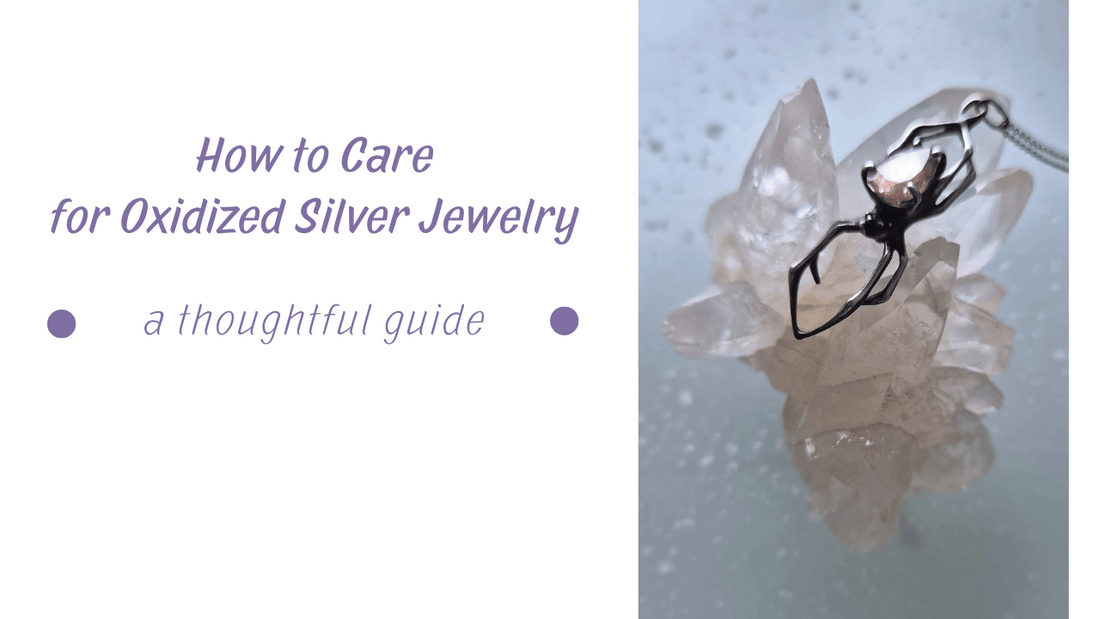
Schmuckpflege. So pflegen Sie oxidierten Silberschmuck
Aktie
Schmuckpflege. Ein durchdachter Leitfaden
Schmuck aus oxidiertem Silber hat eine unverwechselbare Ausstrahlung. Im Gegensatz zu poliertem Silber, das hell glänzt, vermittelt oxidiertes Silber Kontrast, Tiefe und Erinnerungen. Es ist die Art von Oberfläche, die mit der Zeit reagiert – sie wird an manchen Stellen weicher, an anderen dunkler und beginnt, den Rhythmus des Trägers zu reflektieren. Wenn Sie sich in dieses strukturierte, charaktervolle Metall verliebt haben, sind Sie nicht allein. Damit es schön altert, sollten Sie es mit Bedacht pflegen.
Dieser Leitfaden bietet einen ruhigen, strukturierten Ansatz zur Pflege von oxidiertem Silberschmuck, insbesondere in Kombination mit natürlichen Edelsteinen und handgefertigten Details. Egal, ob Sie neu in der Schmuckpflege sind oder Ihre Praxis verfeinern möchten, Sie finden klare, im Studio erprobte Ratschläge, die über die Grundlagen hinausgehen.
1. Schmuckpflege – Was ist oxidiertes Silber?
Oxidiertes Silber ist kein anderes Metall, sondern gewöhnliches Sterlingsilber (92,5 % Silber, 7,5 % Kupfer oder andere Metalle), das gezielt dunkler gemacht wurde. Dies geschieht oft mit einer Schwefelverbindung wie Schwefelleber, die mit der Oberfläche des Silbers reagiert und ihm eine satte Farbe in Anthrazit, Schwarz oder Stahlgrau verleiht.
Dieses Finish ist besonders bei handgefertigtem Schmuck beliebt, da es Texturen hervorhebt – jede Kante, Markierung und jedes geschnitzte Detail kommt durch Schatten noch besser zur Geltung. Es kann ein Gefühl von Alter, Geschichte und Haptik vermitteln. In den Stücken von Bearcat Studio wird Oxidation oft eingesetzt, um dem Schmuck eine skulpturale, organische Präsenz zu verleihen.
Wichtig ist, dass Oxidation nur ein Oberflächeneffekt ist – keine dauerhafte Beschichtung oder Farbe. Mit der Zeit kann sie sich verschieben oder leicht abnutzen, insbesondere an Stellen, die auf der Haut reiben. Diese Entwicklung ist kein Defekt, sondern ein Merkmal – eine Erinnerung daran, dass das Stück bei Ihnen lebt.
2. Wie entsteht oxidiertes Silber?
Die meisten Juweliere oxidieren Silber mit einer der folgenden Methoden:
-
Schwefelleber (LOS): Eine traditionelle Methode, bei der Silber Schwefeldämpfen oder einer erhitzten Lösung ausgesetzt wird, um eine dunkle Patina zu erzeugen. Die Farbe kann je nach Zeit und Temperatur von golden bis schwarz reichen.
-
Chemische Schwärzungsmittel: Einige kommerzielle Lösungen bieten eine kontrolliertere Oberfläche und Konsistenz für die Chargenproduktion.
-
Natürliche Oxidation: Über längere Zeiträume oxidiert Silber durch Einwirkung von Luft und Feuchtigkeit von selbst – dieser Prozess ist jedoch langsam und unvorhersehbar.
Bei Bearcat oxidieren wir Silber gezielt und polieren die Oberfläche anschließend leicht, um Glanzlichter freizulegen. Dadurch bleiben die Schatten erhalten und es werden Dimension und Weichheit hinzugefügt. Die Wahl der Oxidation ist künstlerisch – sie hebt Details hervor, lässt eine Geschichte erahnen und erkennt Unvollkommenheit als Schönheit an.
Manche Stücke sind fast vollständig abgedunkelt, wie diese silberne Fledermauskette, während andere nur in vertieften Bereichen oxidiert sind, um Kontrast zu erzeugen. Betrachtet man dasselbe Design in mattem und oxidiertem Silber, fällt sofort die unterschiedliche Stimmung auf.
3. So reinigen Sie oxidierten Silberschmuck
Pflegetipps für oxidierten Schmuck – Behandeln Sie oxidiertes Silber nicht wie normales Silber. Durch starkes Polieren kann die Patina abgetragen werden, wodurch ein schön ausgewogenes Schmuckstück flach und übermäßig hell wird.
✅ Was ist zu tun:
-
Verwenden Sie ein trockenes Silberpoliertuch, um nur die erhabenen, glänzenden Bereiche vorsichtig zu polieren.
-
Reinigen Sie Spalten mit einer weichen, trockenen Bürste (z. B. einem Make-up-Pinsel), um Staub zu entfernen.
-
Bei Bedarf vorsichtig mit einem feuchten, weichen Tuch abwischen – und sofort trocknen.
❌ Was Sie vermeiden sollten:
-
Handelsübliche Schmuckpflegebäder oder Aufhellungslösungen.
-
Scheuernde Zahnpasta oder Backpulver.
-
Einweichen in Wasser, insbesondere bei Edelsteinen.
-
Ultraschallreiniger oder Dampf.
Wenn Ihr Schmuckstück mit der Zeit stumpfer wird, reiben Sie es vorsichtig mit Ihren Fingern und einem Tuch ab. Oftmals sind die natürlichen Öle Ihrer Haut wirksamer als jedes Produkt.
Und denken Sie daran: Oxidation soll die Optik altern lassen. Es ist in Ordnung, wenn Ihr Schmuckstück mit der Zeit etwas heller wird – das gehört dazu.
4. So lagern Sie oxidiertes Silber (insbesondere mit Edelsteinen)
Zur Schmuckpflege gehört auch die richtige Aufbewahrung. Silber reagiert auf natürliche Weise mit Luft und Feuchtigkeit, was das Anlaufen beschleunigen kann. Viele natürliche Edelsteine vertragen jedoch keine Trockenheit , und Übertrocknung kann dazu führen, dass manche Steine (wie Opal, Türkis oder Mondstein) spröde oder trüb werden.
Beste Speicherpraktiken:
-
Bewahren Sie Schmuck in einer mit Stoff ausgekleideten Schachtel oder einem weichen Beutel auf .
-
Bewahren Sie jedes Stück separat auf, um Kratzer zu vermeiden.
-
Vermeiden Sie den Kontakt mit Chemikalien (Parfüm, Lotion, Haarspray).
-
Nicht zusammen mit Gummi, Latex oder Filz lagern, da diese Schwefel ausgasen können.
-
Vermeiden Sie es, Kieselgel direkt auf Edelsteinstücke aufzutragen. In Maßen ist es in Ordnung, aber nicht gegen Opale oder poröse Steine abgedichtet.
Wenn Sie in einem feuchten Klima leben, kann ein luftdichter Behälter mit einem Anlaufschutzstreifen hilfreich sein. Aber auch hier gilt: Ausgewogenheit ist entscheidend. Schmuck mag, wie Menschen, keine Extreme.
5. Die Schönheit der Patina: Warum sich oxidiertes Silber mit der Zeit verändert
Oxidation ist kein Fehler, den man kontrollieren muss – sie gehört zum Leben des Stückes. Mit der Zeit können Sie Folgendes bemerken:
-
Glänzende Highlights erscheinen dort, wo das Stück die Haut berührt
-
Tiefere Schattenbildung in weniger berührten Bereichen
-
Eine Abschwächung des Kontrasts, die Wärme verleiht
Auch Ihre Umgebung kann eine einzigartige Patina entwickeln: die Zusammensetzung der Luft, die Art und Weise, wie Sie es aufbewahren, die Chemie Ihrer Haut. Jeder Träger hinterlässt seine eigenen Spuren.
Wenn Sie ein Schmuckstück erneut oxidieren lassen möchten , bieten einige Juweliere (einschließlich uns) dies als Service an. Viele Sammler lieben jedoch die sich verändernde Oberfläche – sie spiegelt Gebrauch, Bewegung und Erinnerungen wider. Manche Kunden wünschen sich bei Neubestellungen sogar eine stärker abgenutzte Textur.
6. Pflege von gemischten Materialien: Schmuckpflege für Silber + Steine
Die meisten Bearcat-Stücke enthalten Natursteine – Labradorit, Mondstein, Granat, Prehnit und andere. Viele dieser Steine haben spezifische Empfindlichkeiten:
-
Opale und Türkis können in zu trockener Umgebung austrocknen und reißen
-
Labradorit und Mondstein sind weicher und können Kratzer verursachen
-
Granate sind robust, aber vermeiden Sie starkes Schrubben
Einige Tipps zur Pflege von Edelsteinschmuck:
-
Edelsteinschmuck nicht einweichen.
-
Nicht mit Chemikalien reinigen.
-
Vermeiden Sie längere direkte Sonneneinstrahlung.
Behandeln Sie Ihren Schmuck stattdessen wie eine kleine Skulptur. Wischen Sie ihn sanft ab. Lassen Sie ihn zwischen dem Tragen ruhen. Beobachten Sie, wie er reagiert.
7. Im Studio: Wie wir unseren Schmuck fertigstellen
Bei Bearcat Jewelry ist jedes Silberstück:
-
Handgeschnitzt oder in kleinen Mengen gegossen
-
Von Hand oxidiert
-
Leicht poliert, um die Textur freizulegen
-
Mit einem weichen Tuch nachbearbeiten, niemals mit einer Poliermaschine
Wir streben nicht nach Perfektion – wir streben nach Präsenz . Unsere Stücke sollen lebendig, unvollkommen und tief greifbar wirken. Oxidation ist hier kein „Antikeffekt“, sondern eine Stimme.
8. Schmuckpflege - Häufig gestellte Fragen
F: Warum wird mein Silber gelb oder grün?
Dies kann durch den Kontakt mit Parfüm, Lotion oder sogar Gummi verursacht werden. Waschen Sie die Stelle vorsichtig mit warmem Wasser und trocknen Sie sie mit einem weichen Tuch ab.
F: Kann ich oxidiertes Silber jeden Tag tragen?
Ja – aber rechnen Sie damit, dass sich die Patina entwickelt. Bei Bereichen mit hoher Reibung (wie Ringen) kann mit der Zeit eine erneute Abdunkelung erforderlich sein.
F: Kann ich oxidierte Bereiche wiederherstellen, die verblasst sind?
Ja – manche Leute verwenden Schwefellebergel zu Hause (mit Vorsicht), wir empfehlen jedoch, dies von Ihrem Juwelier richtig machen zu lassen.
F: Kann ich mit meinem Schmuck schwimmen oder duschen?
Am besten entfernen Sie es. Chlor und Salzwasser wirken sich negativ auf Metall und Stein aus.
F: Ist eine Verdunkelung ein Zeichen für schlechte Qualität?
Nein. Natürliches Anlaufen ist nicht dasselbe wie absichtliche Oxidation. Oxidierte Stücke sollen sich verändern – das macht ihre Schönheit aus.
F: Kann ich oxidiertes Silber mit poliertem Silber in einem Outfit kombinieren?
Auf jeden Fall. Der Kontrast kann einen überzeugenden, vielschichtigen Look erzeugen.
9. Abschließende Gedanken: Schmuck als lebendiges Objekt
Bei der Pflege von oxidiertem Silber geht es nicht darum, Perfektion zu bewahren – es geht darum, etwas Lebendiges zu pflegen. Diese Stücke bewahren Schatten und Glanz, Textur und Zeit. Sie müssen nicht gefroren bleiben. Sie müssen atmen.
Tragen Sie sie. Lassen Sie sie mit Ihnen gehen. Lassen Sie sie sich verändern. Wenn sie weicher werden oder sich verändern, ist das kein Makel – das Stück reagiert auf Ihr Leben.
Schmuck ist mehr als nur Material. Er ist Erinnerung, Bedeutung, Bewegung.
Und wie Sie verdient es sanfte Aufmerksamkeit.
— Mit freundlichen Grüßen aus dem Studio.
Bearcat Schmuck
Bei Fragen können Sie uns gerne überReddit , Instagram oder den Kontaktbereich dieser Website kontaktieren.

